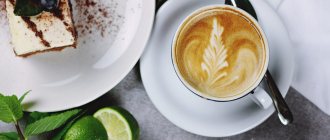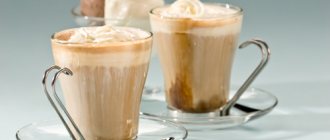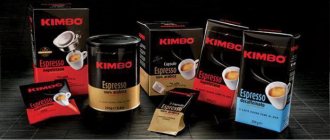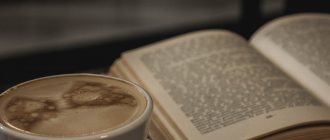In the coffee universe, the first position is undoubtedly held by coffee with milk, which is an order of magnitude ahead of the basic “black coffee”: even inexperienced coffee lovers know such types of drinks as lattes and cappuccinos. In addition to the classics, there are other recipes that are easily distinguished by true connoisseurs. One of them is flat white coffee, which is gaining more and more popularity and love around the world every year. In this article we will understand the difference between coffee and milk drinks from the TOP 3 list, learn the history of flat white coffee and what it is, and also learn how to prepare it correctly.
History of origin
Flat white coffee was first prepared in the 1980s by an unknown New Zealand barista who experimented with the combination of coffee and milk.
He set himself the task of preserving and emphasizing the pristine taste of white coffee with a brighter interpretation of coffee notes, as well as the abandonment of abundant milk foam.
The bright, invigorating recipe for “coffee with milk” was liked by the guests of the coffee shop: after some time it was prepared in all cafes in Australia and New Zealand.
Flat white owes its worldwide fame to coffee lovers in Great Britain: the British liked it so much that some time later its name in Britain was synonymous with quality coffee.
Many Europeans who ordered coffee white were dissatisfied with the drink they brought: the cappuccino was topped with a huge head of milk foam, while there was practically no coffee.
The situation was no better with the latte, in which the coffee taste was drowned out by milk. Baristas working in large chain establishments (McDonald's, Starbucks, etc.) knew how to prepare only such classic variations, as well as the black version.
The appearance of a drink balanced in proportions “coffee and milk”, in which there was no foam, created a sensation. Due to its appearance - the absence of a mountain of foam similar to a meringue - the name was assigned to the drink, literally translated as “flat white”.
By the end of the 1990s, “flat coffee” became part of the daily diet of coffee bean connoisseurs in Europe and the United States.
Flat white became a cult drink, distributed throughout all cafes and restaurants of the Old and New Worlds thanks to the small London coffee shop Flat White, opened in 2005 by New Zealand entrepreneurs Cameron McClure and James Gurnsey. Over the course of a day, more than 700 servings of the original drink were ordered from the cafe.
An original drink from New Zealand
Flat white coffee has received worldwide love and recognition. New Zealand is the birthplace of this drink. A country famous for its lush green pastures and delicious full-fat milk, which has become the main highlight of the new drink.
The coffee roaster, who also worked as a barista in an Auckland coffee shop in the 1980s, turned out to be an inquisitive guy. He began mixing the ingredients at hand, changing their proportions, degrees of processing, and temperature. One of the options suited him. The drink was called a flat white. The ideal ratio of coffee and milk was found to be approximately 1:2.
Unlike cappuccino, on the surface of which frothed milk is placed in a cone-shaped mound, flat white coffee is covered with a thin layer of milk (about 0.5 cm). The flat shape of the milk froth determined the name of the popular coffee drink - literally “flat white”. Now it is prepared in most coffee shops in America and Europe, and in England the cocktail is always included in the menu.
Flat white coffee: recipe
The official recipe used to prepare flat whites all over the world, from your favorite neighborhood coffee shop to Starbucks or McDonald's:
- Milk (110 ml per 1 cup) is whipped with a cappuccino maker until a light foam of velvet consistency is obtained (required temperature - 65°C).
- The preheated cup is placed in the coffee machine tray.
- Prepare 1 serving of double espresso (60 ml).
- If desired, 0.5-1 part of a packet of sugar is added to the espresso (the recipe does not regulate).
- Frothed milk is poured into the espresso (without creating the chopped structure characteristic of a latte)
Output drink parameters:
| Index | Meaning |
| Caffeine content | 110-116 |
| Foam thickness | 25 mm |
| Temperature | 67-70°C |
Recommendations on how to prepare true flat white:
- choice of variety: to optimally emphasize the taste of coffee beans, you should take a blend of several varieties of Arabica without Robusta impurities;
- To obtain the ideal shade of taste, Kenyan and Indian varieties with a chocolate flavor are suitable;
- the optimal grind is medium, fine espresso is also suitable;
- degree of roasting - light or medium;
- sugar must be added during cooking;
- milk should be whole, with a fat content range of 2.5-3.2%.
The minimal volume of flat white milk foam allows you to create designs on it in accordance with the best latte art standards: the foam is dense, and you can create complex, beautiful images on it.
How to make a New Zealand drink
While everything is clear with the preparation of coffee for flat whites, there are disagreements with the creation of the correct foam.
What kind of coffee is required
- preference is given to soft varieties of Arabica (from Guatemala, Colombia, Ethiopia, Kenya) of light roast; medium roast is allowed, but in no case dark. Such a product will contrast too much with milk;
- Coffee should preferably be roasted fresh, ideally immediately before grinding. In this case, you will eliminate the bitterness and achieve an amazing aroma of the drink;
- Grinding of grains is required fine, fine;
- To prepare espresso, non-chlorinated pure water with a soft degree of mineralization (up to 250 mg/l) is used.
The coffee machine brews double espresso - “doppio”; if you want a richer coffee taste, it is not forbidden to prepare “triple espresso” - triple espresso. The volume of the drink in the first case is 60 ml, in the second 90 ml. A rich, thick ristretto of the same volume will also work.
It takes longer to brew coffee in a Turkish coffee pot, but the quality of the drink will not be inferior to the mechanical method of preparing it. Strong, aromatic oriental coffee after straining will be an excellent basis for a flat white.
If you want to sweeten your cocktail, add sugar to hot coffee and stir until the crystals are completely dissolved.
Milk controversy
There are different approaches to preparing foam. The requirements for the quality of milk are unanimous: it must be fresh, whole, with a fat content of 2.5 - 3.5%. There is one more episode with which the manufacturers agree, but we will attribute it to bartenders who have professional equipment at hand or are happy owners of expensive coffee machines. Smart units have a hard-working cappuccino maker, which with a powerful jet of hot steam will quickly whip up the foam of the correct structure. You just need to get used to the process a little.
If you have a milk frother (mini mixer) or a French press at hand, that’s also enough. You can do this:
- Divide a portion of milk into 2 equal parts. Heat one on the stove or in the microwave. The temperature of the product should not exceed 70°, and should not be brought to a boil under any circumstances. While the first part is heating, the second is whipping, but not too much. We create a homogeneous, soft, plush-looking foam. The heated milk is then poured into the finished espresso and the frothed milk is placed on top. Its upper border should coincide with the edge of the cup. It turns out to be a flat white field and a great desire to decorate it with something. Well, please! Cocoa powder, light toppings, personal artistic abilities at your service.
- Whip all the milk into a thick, tight foam. The main part (about 2/3) is carefully and patiently mixed with espresso in a large glass. The consistency of the coffee becomes very soft and airy. The finished coffee and milk “sbiten” is poured into a thick-walled ceramic cup, and the rest of the foam is placed on top.
- Experienced baristas, who do not have enough time for the above-described manipulations, quickly prepare the milk additive for the cocktail. The entire volume of milk is whipped until a 1 cm layer of foam is obtained. It is poured into a cup of coffee. The milk quickly penetrates into the coffee layer, leaving a white, dense and flat “plain” on top.
From personal experience. I like to make foam for flat whites using a French press. I take the milk out of the refrigerator. I heat approximately ¾ of its volume in the microwave for no more than 1 minute at medium power. I beat a small part of it cold in a French press, I have a small one, 300 ml. Cold milk froths very quickly, the foam is beautiful, dense, practically free of bubbles - just what you need. It also needs to be heated for just a few seconds directly in the glass flask of the French press. Further according to plan: pour warm milk into strong coffee, place foam on top, form not a dome, but a flat lid. It is better to sweeten coffee with dark cane sugar; it adds a pleasant caramel note to the taste.
The calorie content of flat white coffee depends on the fat content of the milk and the presence of sugar. By using skim milk for preparation, without adding sugar, and drinking 100 ml of the drink, you will receive no more than 50 - 60 Kcal. Milk fat content of 3.2% will increase the number of calories to 75. The main nutritional value of the drink lies in the proteins and fats contained in cow's milk.
Features of cooking at home
If you learn how to make an invigorating coffee drink, you can enjoy its taste at a much lower price. The main thing is to solve two main problems:
- Brew strong espresso. A Turkish press, a French press, and a coffee maker are suitable for this. If all of the above is not available, use a saucepan.
- Whisk the milk. A cappuccino maker that is missing in the kitchen can easily be replaced with a blender or mixer. Before churning, the milk is heated over low heat.
Baristas from all over the world have not yet come to a consensus on how to properly prepare frothed milk for a flat white. There are 3 options:
- The milk is whipped quickly until a layer of 1 cm of velveteen foam is formed;
- Two parts of milk are used: the first is heated to +65 °C, the second is whipped until a thick foam forms. First of all, unfrothed milk is poured into the espresso, after which a thin layer of milk foam is added.
- Low-fat milk is whipped until a significant volume of foam, homogeneous in structure and smooth, is formed. If you prepare a flat white according to this recipe, the taste of the finished drink will be pleasant, with a velvety tint, but this will be a departure from the classic recipe of the original flat white.
What recipe to use for preparing milk for a flat white is up to you. You can experiment and choose the option you like best. In most coffee shops in Moscow, as well as other Russian cities, they use the first method.
Americano
This is Americano
This is the only drink on our list that is made only from coffee.
To create an Americano, espresso is mixed with water at a temperature of 90°C. Add 1 serving of coffee to a 200 ml glass, and two to 300 ml and 400 ml.
The foam on top is formed by oils and is called crema. It is formed when preparing coffee under high water pressure, so it does not appear during brewing in a Turk or French press.
Basically, crema consists of oils, proteins and carbon dioxide, which is released during frying and for two weeks after it. Therefore, there will be more foam if the grain is fresh.
What is the difference between cappuccino, latte and flat white
Many consumers cannot understand what makes a flat white different from a classic cappuccino and latte. In fact, there are a lot of differences from lattes and cappuccinos, both in appearance and in taste characteristics.
The main differences between a flat white and a latte:
- pronounced taste, not drowned out by milk;
- 2 times less milk foam;
- 2 times more caffeine (in a latte - 1 shot of espresso);
- significantly lower calorie content, since flat white contains less milk.
What is the difference between flat white and cappuccino:
- more coffee taste (not 1 part of espresso is used, but 2);
- milk foam is 4 times thinner;
- the foam is dense, without a loose structure;
- In terms of calorie content, a flat white is slightly inferior to a cappuccino (per 100 ml); how many calories in the final drink depends on its volume. So for a double cappuccino with syrup, the amount of kcal is 2-3 times higher than that of a classic “flat white” without sweets.
In schematic form, the difference between flat white, cappuccino and latte is shown in the photo.
Short list of drinks
To help you remember, keep a cheat sheet with key details for each coffee:
Americano is made from espresso and water. There is one shot of espresso in a small glass, two in a medium and large glass.
First pour coffee, then water. A thin cream, a mixture of oils and carbon dioxide, forms on the surface. There's only coffee taste here.
Cappuccino is made from espresso and milk with a high foam of 2 cm. There is one shot of espresso in a small glass, two in a medium and large glass.
First pour coffee, then milk, mix. Add milk. The coffee taste is dominant.
Lattes are made from espresso and milk with an average foam of 1.5 cm. There is one shot of espresso in a small glass, and two in a medium and large glass.
First they pour milk, then coffee, then milk. The milky taste is dominant.
Flat whites are made from espresso and milk with a low foam of 0.5 cm. There are two shots of espresso in a small glass, on average there are three, and in a large glass there are four.
First, almost all the milk is poured, then coffee, then milk foam. The coffee taste is the leader, and the caffeine is the most.
Rough is made from espresso, cream and vanilla sugar with a low foam of 1.5 cm. There is one shot of espresso in a small glass, two in a medium and large glass.
Mix coffee and milk, add vanilla sugar and beat with a steam wand. The creamy taste dominates.
PS Everything was filmed on an iPhone. I remind you of our reviews and prices for the main Apple smartphones:
iPhone 12 review (price from RUB 79,990) iPhone 12 Pro review (price from RUB 99,990) iPhone 12 Pro Max review (price from RUB 109,990) iPhone 12 mini review (price from RUB 69,990)
iPhones.ru
Add to bookmarks, this list will be useful to you.
How to Serve and Drink Flat White
Cafes that monitor their reputation regulate and closely monitor not only how to properly prepare a flat white, but also how to serve it to a guest:
- Traditional dishes are thick-walled ceramic cups; the use of glass glasses is a gross violation of tradition;
- Despite the fact that the drink should not be stirred, a spoon and a bag of sugar are placed with the cup. To avoid embarrassment, it is better to immediately find out about the sugar preferences of everyone who plans to drink a flat white.
- “Flat coffee” tastes best combined with chocolate desserts, crispy cookies, and fruit sweets.
Despite the excellent taste, invigorating effect and low calorie content, you should not overuse flat white: the recommended dose per day is no more than 2 cups.
Now you have a good understanding of the recipe and ingredients of New Zealand white coffee, and you can easily distinguish it from a latte or cappuccino. Perhaps the concentrated taste and balanced aroma of this soft and at the same time invigorating drink will not leave you indifferent and you will replace your usual morning cappuccino with it.
Espresso
Espresso is the quintessence of coffee taste, the base of any classic coffee drink. This is not a type of coffee tree, not the name of a coffee mixture, but a method of preparing coffee, which requires compliance with certain conditions. The essence of the method is that water at a temperature of about 90°C is passed through a filter with ground coffee under a pressure of 9 atm. The volume of an espresso serving is 25-30 ml. Many people have the wrong idea about espresso, thinking that it is simply a dark, bitter drink with a burnt coffee taste. This misconception arises due to the fact that espresso often has a strong, rich, concentrated or strong taste. But not bitter at all. Espresso is quick to prepare, has an original aroma and is often referred to as a drink for true gourmets and coffee connoisseurs. Compared to other coffee drinks, espresso gives you the same dose of caffeine in a smaller volume of liquid, which allows you to preserve the original aroma and flavor notes. Espresso, by definition, should be intense and rich. The skill of a good barista is to create a balanced taste of this drink. There are many factors to consider when making espresso: grind size, water temperature, freshness of the beans and pouring time. Doesn't it look a little more complicated than just 30ml of the drink? Drinking a shot of espresso is the best way to appreciate the true taste of coffee, its richness, chocolate or fruity taste and different shades of aromas. You should drink espresso immediately after serving, before the gas layer evaporates and the coffee cools down. Cooled espresso tastes radically different from freshly prepared espresso.
Recommendations
Flat white should be drunk warm, without stirring the drink, so that the coffee, passing through the milk foam, acquires a delicate aftertaste. It is recommended to drink no more than one mug in the first half of the day, as the drink is quite strong and contains a large amount of caffeine.
Any sweet desserts go well with coffee: shortbread cookies, muffins, chocolate, fruit and berry jellies and mousses.
Due to its popularity, flat white coffee is offered in all famous chain coffee shops in the world, such as Starbucks, Costa Coffee and Pret a Manger. The price varies between 250-300 rubles per cup. If you wish, you can try other types of flat white coffee and compare their taste.











